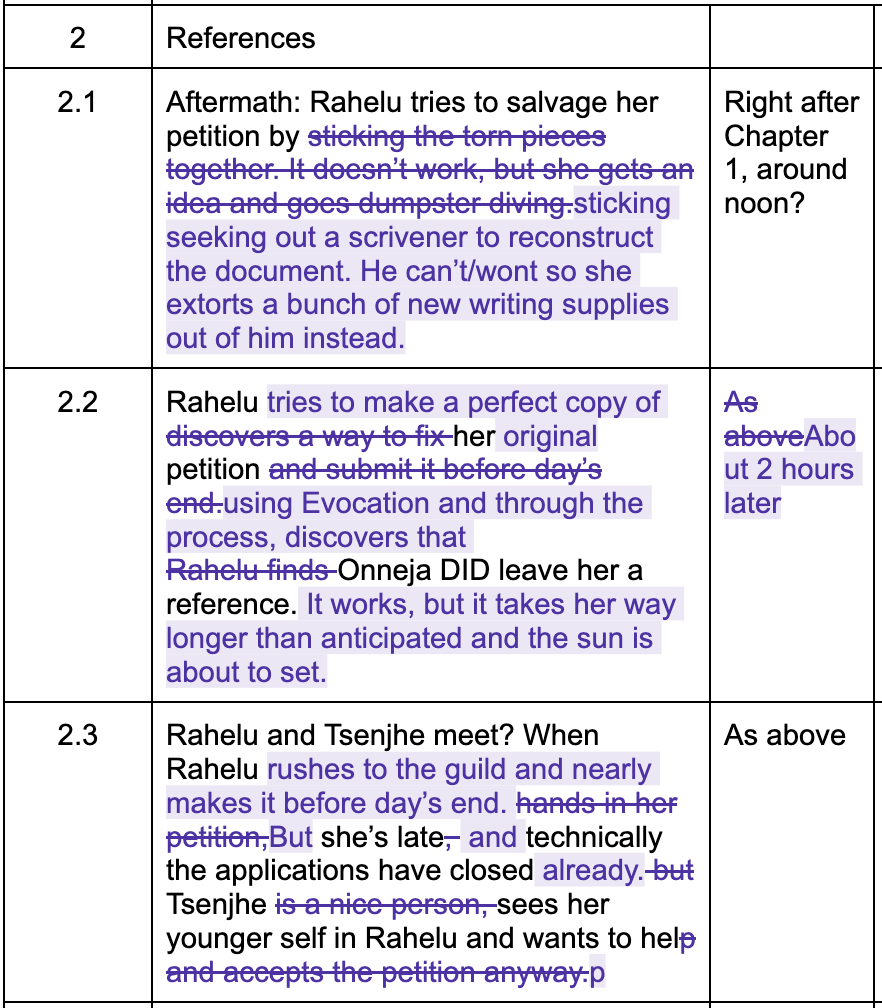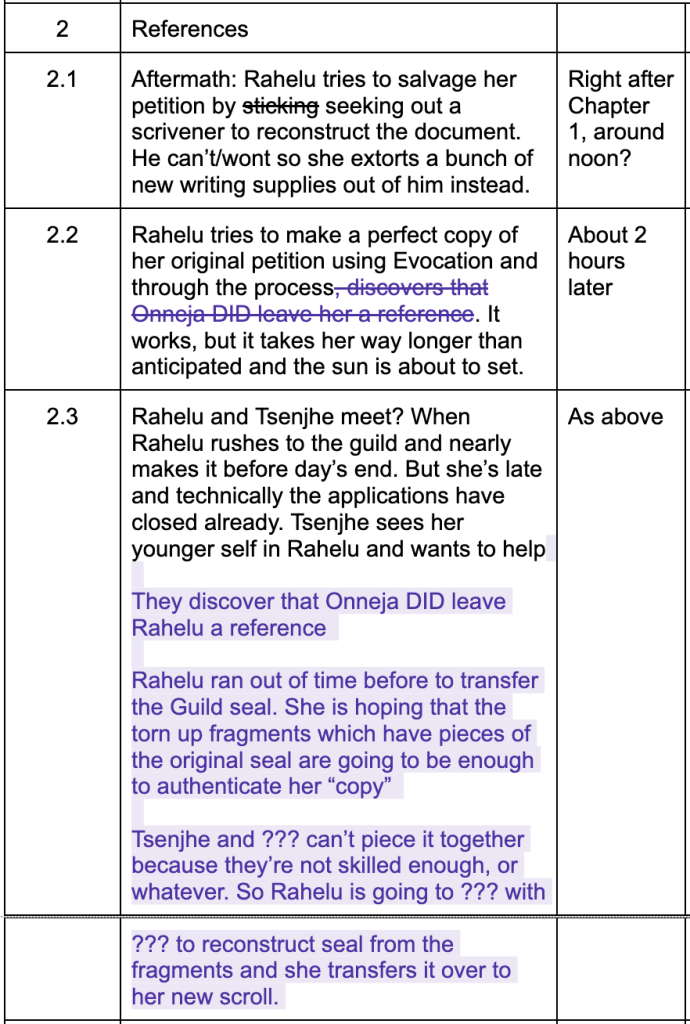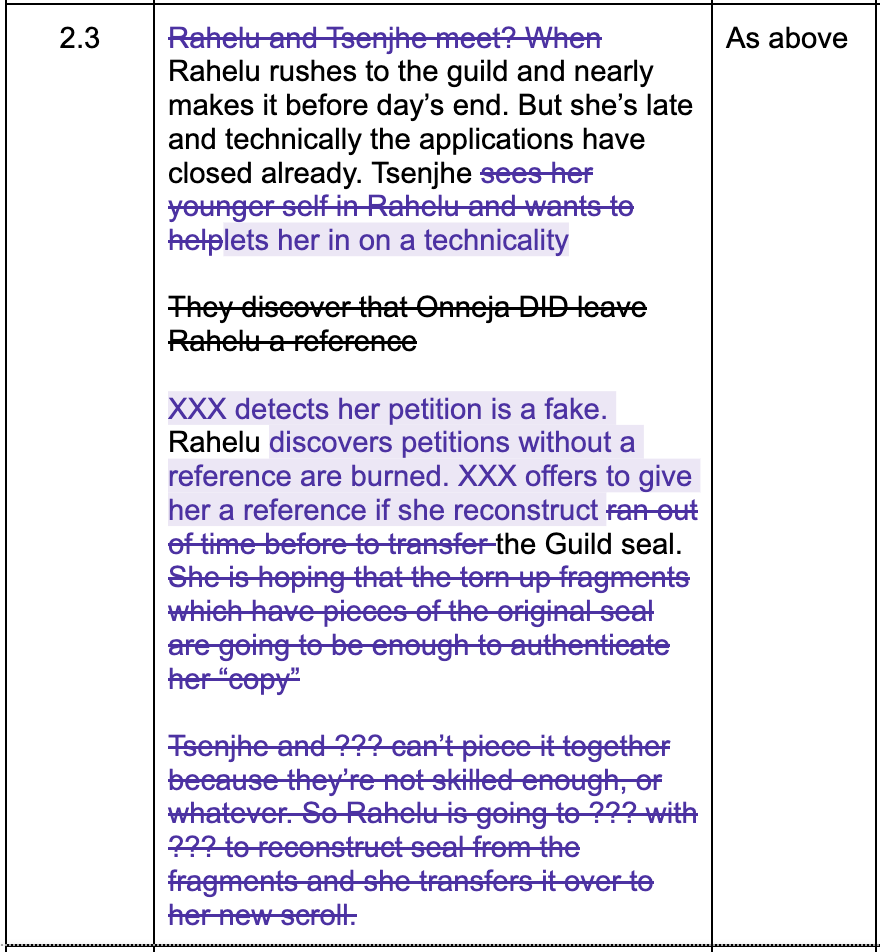One of the most unintuitive things I have discovered about myself as a writer is that I am, apparently, incapable of sticking to an outline.
I just can’t do it, despite my tendency to being structured and methodical in my approach to most things in life. I’ll make comprehensive lists of things that should happen in the plot and map out my turning points, then I’ll open up a blank document and my brain will go, “Awww, how adorable, but actually no, we’re writing about this instead.”
At the same time, it’s hard for me to start from absolutely nothing. I need some sort of framework, however loose, to be able to put down new prose. Otherwise, I end up sitting there, staring at a blinking cursor on a blank page, second-guessing every word that comes to mind.
So, what I’ve found works really well for me, is Brandon Sanderson’s approach:
I plan my worlds in great detail before I start writing, in most cases, and I plan my plots in moderate detail. I plot backward, I start with what I want to have happen for a plot cycle…and then I list a bunch of bullet points underneath.
…
My characters, I figure out who they are when the book starts, but I do not outline them in great detail…which means I have to have a flowing outline where, once I’ve started writing my way into the character I will then have to rebuild the outline periodically to match the person they’re becoming, which sometimes rips apart that outline quite a bit.
—Brandon Sanderson, Shadows of Self Newcastle UK signing (Oct. 20, 2015)
When I have the big, overarching pieces of my world and my characters’ motivations established, and a clear situation, it becomes much easier to write. Instead of sitting in front of my computer, wondering ‘how do I write a good book?’ (a question to which there is no right answer), I can ask myself a set of concrete questions:
- What’s the situation?
- How does my viewpoint character feel about that situation?
- How do the other character/s in the scene feel about that situation?
- Given their motivations, what would my viewpoint character do?
I find this method a lot easier than to work to because I can make myself empathize with them. But it does mean that when I write, I generally have to write scenes in sequential order, otherwise I have trouble with consistency in my characters.
It also means that I often end up outlining, then re-outlining as I go. I tend to over-outline too, which means I often severely underestimate how much plot and character development I can cover. (Exhibit A: this book, which was supposed to be 75,000 words long. Yeah.)
Chapter 5 is a weird chapter. It’s one of the few scenes in Petition that were written out of order during the first draft.
(There are other scenes that were written out of order by virtue of being scenes I inserted to address alpha and beta reader feedback, but those don’t really count in the same way.)
Originally, Chapters 3 and 4 were just one long chapter. The extent of my outline for it was this—the tracked changes show you what I adjusted after every writing session. This screenshot is from the point right after I had finished writing the first draft of the scene with Xyuth but before I got all the way through her Evocation up at Stormbane’s rest:

Hilariously, Keshwar isn’t in the outline at all at this stage. Pretty much everybody other than Rahelu, her parents, Onneja, and Tsenjhe didn’t really exist in the outline. They all just…kind of happened during the writing process.
Here’s the revised outline (again) after I started writing the scene inside the Guild courtyard. Note the ridiculous amount of question marks and how the details bear no resemblance to what I actually ended up writing:

And halfway through the scene, I figure out that I’ve made things way too complicated, so I start simplifying:

Scene 2.3 was still 2,695 words long by the time I was done with the significantly simplified version, and the chapter overall was at 7,226 words. I got to the end of the scene and felt like the next logical progression from a character and relationship perspective was a scene with Tsenjhe and her parents at home, which would have all of Rahelu’s worlds colliding.
Conceptually, it was a scene that should work.
At the same time, I did not actually want to write Keshwar and Tsenjhe paying a visit to Rahelu’s parents.
So I skipped it and went on to write the next chapter, which opens on the day of challenges.
Later, after I decided to restructure the book, I came back and wrote the scene with Keshwar and Tsenjhe escorting Rahelu home.
It’s a very introspection-heavy scene, which makes me worry. Introspection is hard to do well; writing too little of it means you often don’t get a sense of the POV character but writing too much can feel like pointless bloat.
Worse, it’s a scene where there is no obvious conflict and Rahelu has no overt purpose she’s pursuing. She’s pretty much just a passive observer, freaking out in her head the whole time.
So no surprises here: my alpha and beta readers were kind of confused as to why this scene was here at all. My gut feeling is that the change of pace is necessary. We’re at the end of a big, action-heavy opening arc; we need some sort of denouement to the resolution that yes, she’s in, her Petition has been accepted.
In the end, I left the scene in but tweaked a few lines right at the very end. I wanted to hint at a sense of a calm before the storm, that the stakes—high as Rahelu thought they already were—are being raised, and some hints at bigger things happening in the background that Rahelu isn’t aware of. (And won’t be in a position to be aware of for a long time.)
Does it work?
I think it does. The last line in the scene is a nice little callback to the tone promise in the prologue, and the additional details that Rahelu observes in her final interaction with Keshwar foreshadow something that happens at the midpoint of the book.
Overall, I’m pretty pleased with how it turned out; I think having this scene here makes for a much stronger transition than an abrupt cut from the end of Chapter 4 to the beginning of Chapter 6.
Leave a Reply